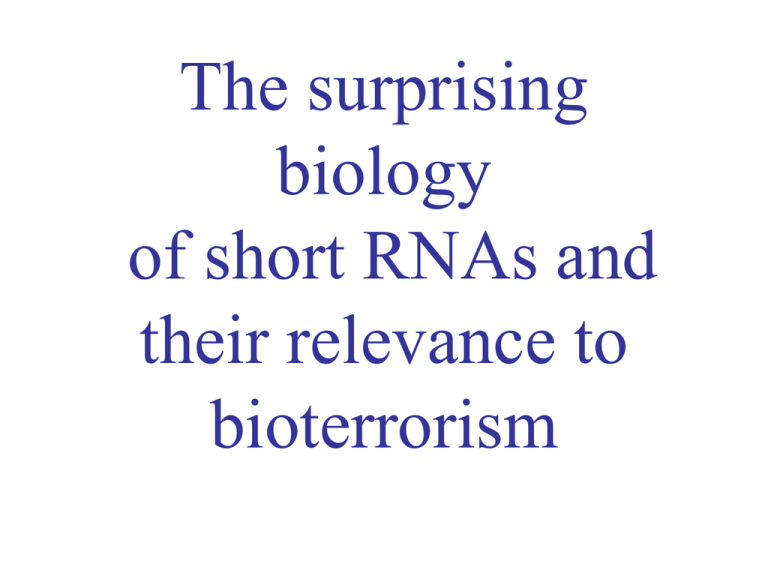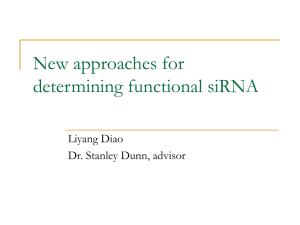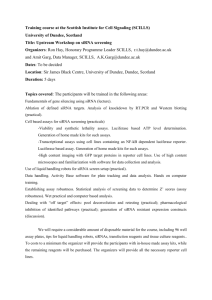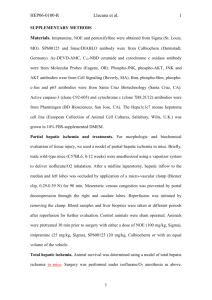Click here for Professor Sharp's powerpoint slides from this talk.
advertisement

The surprising biology of short RNAs and their relevance to bioterrorism RNAi Discovery • • • • • • • • • C. elegans (Fire et al., 1998) Drosophila (Carthew et al., 1998) Planaria (Newmark et al., 1998) Trypanosomes (Ullu et al., 1998) Hydra (Lohmann et al., 1999) Zebrafish (Wargelius et al., 1999) Mice (Wianny & Zernicka-Goetz, 2000) “cosuppression” in plants “quelling” in Neurospora 3’ 5’ p 3’ p 5’ Short RNAs silence by mRNA degradation turnover Drosophila and mammals worms and plants Therapeutic gene silencing DNA mRNA Proteins Receptors Enzymes Therapeutic gene silencing Protein Therapeutics DNA mRNA Proteins Receptors Antibodies Enzymes Small Molecules Therapeutic gene silencing Protein Therapeutics DNA mRNA Proteins Receptors Antibodies Enzymes Small Molecules Therapeutic gene silencing siRNA DNA mRNA siRNA Therapeutic gene silencing DNA mRNA siRNA silences mRNA --blocks protein production Alnylam overview •Leader in RNAi therapeutics Strong and experienced team • • ~140 employees by year end; Cambridge, MA Key founders: Sharp, Tuschl, Schimmel, Zamore, Bartel Commitment to scientific excellence • Multiple papers in world’s top journals – Nature, Nature Medicine, Cell, etc. Strong product focus • • ALN-RSV01 – Phase II Experimental Infection Study initiated June 2007 Rapidly developing pipeline – 1 new IND by end ’07/early ’08 – 1-2 addiitional INDs in ‘08 – Multiple pre-clinical programs Leading IP • • Only company with access to all issued or granted fundamental IP on siRNAs – Unambiguous FTO – Blocking position in entire field >150 issued chemistry/delivery patents (Isis, Tekmira, etc.) Industry-leading collaborations and partnerships • • • 5 distinct partnerships with 4 major life science companies – Medtronic, Novartis, Biogen Idec, and Roche Significant federal funding MicroRNA therapeutics with Regulus Therapeutics, LLC Well-capitalized • • • • 2004 IPO, NASDAQ: ALNY Raised ~$750M to date – ~$250M raised in private/public equity – ~$500M raised in realized partnership funding Q2 ’07 cash of ~$195M; Y-E ’07 cash >$435M ~$1.25B market cap Use of siRNA in therapy 1. Most diseases are the results of genes: virus, cancer (oncogenes and cell death), Parkinsons (alpha-synuclein). 2. Gene specific silencing but some off-target effects a) partially sequence-specific (positions 2-8 from 5’ end) b) 1.4 to 2 fold at mRNA level. 3. Delivery of siRNA to interior of cells in vivo is a challenge a) direct to organ (eye) b) systemic to organs. Turning siRNAs into drugs • Choose potent and specific sequence Cholesterol, others » Bioinformatics, in vitro assays • Stabilize against exonucleases » Phosphorothioate • Stabilize against endonucleases Phosphorothioate 2’OMe, 2’F Incorporate minimal number of modifications required for appropriate pharmaceutical properties » 2’OMe, 2’F • Add conjugate to improve biodistribution » Cholesterol, others Respiratory Syncytial Virus (RSV) Program • •Harness RNAi to treat a major infectious disease – Significant unmet medical need • • • • >125,000 pediatric hospitalizations/yr in US >170,000 adult hospitalizations/yr in US Annual cost is >$750 million Significant morbidity including asthma – No effective therapies to treat RSV infection • Synagis used for prevention – ALN-RSV01 in Phase II clinical development • Target: RSV nucleocapsid “N” gene – Highly conserved gene – Essential for viral replication In Vivo anti-viral activity of siRNAs rodent prophylaxis model Log10 PFU/g lung 6 1 mg/kg 2 mg/kg 4 mg/kg 5 4 3 2 1 0 LLOD P1 P2 P3 P gene siRNA i.n. (25-100ug) RSV Symposium, Aug. 2005 ALNRSV01 N2 N gene 4 hrs L1 L2 L3 P4 P4-MM L gene Virus (RSV/A2) i.n. (106 pfu) 4 days Viral Titer in Lung In Vivo anti-viral activity of siRNAs rodent treatment model Log10 PFU/g lung 6 Day 1 Day 2 Day 3 Day 4 5 4 3 2 1 LLOD 0 PBS P1 Virus (RSV/A2) i.n. (106 pfu) RSV Symposium, Aug. 2005 ALN-RSV01 Day 1 Day 2 Day 3 Day 4 siRNA Single dose i.n. (2 mg/kg) L3 Day 5 P4-MM Viral Titer in Lung Alnylam biodefense Viral Hemorrhagic Fever Programs • RNAi Therapeutic targeting the Ebola Virus – – – – September, 2006 NIAID/NIH/DHHS $23M 39 month contract through IND filing • Host-Directed RNAi Therapeutic for Ebola Virus and Other Hemorrhagic Fever Viruses – – – – August, 2007 DTRA/DoD $38M 33 month contract through Phase 1 studies RNAi therapeutic targeting the Ebola virus – Develop RNAi anti-viral targeting Ebola • • Severe, often fatal infection Collaboration with USAMRIID (Drs. Bavari and Warfield) – Target all pathogenic strains • Zaire and Sudan – Non-biased approach to selecting viral gene targets RNA Structural: L VP30 VP35 NP Membrane -associated: VP24 VP40 GP In Vivo delivery to appropriate cells ● Macrophages and dendritic cells are primary cells involved in early infection ● Hepatocytes and other parenchymal cells involved in late infection Bray and Geisbert, Int. J. Biochem. Cell Biol. (2005) 37:1560-6. USAMRIID In vitro proof of concept Ebola siRNA reduces viral titer by over 90% EBOV-ZAIRE siRNA; 48h time point No siRNA Negative siRNA VP24 siRNA #1 1 log reduction in viral titer with unmodified siRNA VP24 siRNA #2 VP35 siRNA #1 VP35 siRNA #2 NP siRNA #1 NP siRNA #2 L siRNA #1 L siRNA #2 1 000 10 000 100 000 1 000 000 10 000 000 Plaque Forming Units / ml Protocol: siRNA was transfected into 293T cells and cells were infected next day. Viral titer was measured after 48h in the sup by plaque assay. Data: Kelly Warfield and Sina Bavari, USAMRIID Liposomal formulations for systemic RNAi – Liposomes are organized lipid nanoparticles used in pharmaceutical drug delivery • Used in over 12 approved drugs – Enables delivery of siRNAs into cells siRNA • Highly efficient for liver delivery In vivo proof of concept Liposomally delivered Ebola siRNA protects from lethal infection ● Guinea pig Zaire EBOV infection model ● Pooled Ebola or scrambled siRNA ● 1 mg/kg siRNA in SNALP2 liposomal formulation given i.p. 1 hr after EBOV infection and then daily on days 1-6. ● Sacrifice on day 7 for viremia (n=5 per group) Reference: Geisbert et al., JID (2006) 193:1650-7. Broad spectrum RNAi therapeutic for Ebola virus targeting an endogenous host factor Coagulopathy Host-directed viral assembly and budding Critical cell signaling molecules •RNAi Therapeutic silencing of host genes involved in the pathogenesis and diathesis associated with viral hemorrhagic fever infections including hemorrhage and enhancement of viral assembly by host proteins The discovery of 250 to 1000 new genes that encode microRNAs. These probably regulate 25-50% of all genes in vertebrates. V. Ambros (Lee et al. 1993) L. Ruvkun (Wightman et al. 1993) T. Tuschl (Lagos-Quintana et al. 2001) D. Bartel (Lau et al. 2001) V. Ambros (Lee and Ambros, 2001) MicroRNAs silence by translational inhibition and mRNA degradation Proposed anatomy of miRNA/mRNA interactions 8 nt “seed” 3’- -5’ lin-14 mRNA lin-4 miRNA V. Ambros (Lee et al. 1993) L. Ruvkun (Wightman et al. 1993) The discovery of 250 to 1000 new genes that encode microRNAs. These probably regulate 25-50% of all genes in vertebrates. V. Ambros (Lee et al. 1993) L. Ruvkun (Wightman et al. 1993) T. Tuschl (Lagos-Quintana et al. 2001) D. Bartel (Lau et al. 2001) V. Ambros (Lee and Ambros, 2001) The expanding biology of miRNAs • differentiation : miR-181, lsy-6, miR-1 • apoptosis : bantam, miR-14 • proliferation : miR-17-94 cluster, let-7 • developmental timing : lin-4, let-7 • morphogenesis : miR-430 “Control of stress response” Literature on microRNA and stress Heart-specific miR-208 regulate stress-dependent cardiac growth in mice (Rooij et al., Science 2007) A model for the role of miR208 in cardiac gene regulation (Fig 6, Rooij et al., Science 2007) Thank you for the opportunity to present this lecture Alnylam IP Leadership Over 150 issued patents in major markets: US and EU Fundamental IP Required for all siRNA therapeutics US 5,898,031: Crooke US 6,107,094: Crooke US 6,506,559: Fire and Mello EP 1144623: Kreutzer-Limmer EP 1214945: Kreutzer-Limmer EP 1230375: Glover EP 1407044: Tuschl II* US 7,056,704: Tuschl II US 7,078,196: Tuschl II Additional pending Chemistry & Delivery IP Required to introduce “drug-like” properties and achieve delivery >150 issued patents in-licensed from Isis, including – US 7,138,517: Cook US 7,078,196: Tuschl II Key patents from Inex, including – US 5,976,567: Wheeler – US 6,815,432: Wheeler – US 6,858,225: Semple Many additional pending *Received Rule 51(4) EPC notification from EPO; equivalent to NOA from USPTO Target IP Relate to siRNAs for specific disease targets US 7,056,704: Tuschl II – Covers any and all targets in mammalian cells EP1352061: Kreutzer-Limmer II – Covers >125 disease targets Viruses Cytokines Oncogenes/Cell cycle Many others Many additional pending






